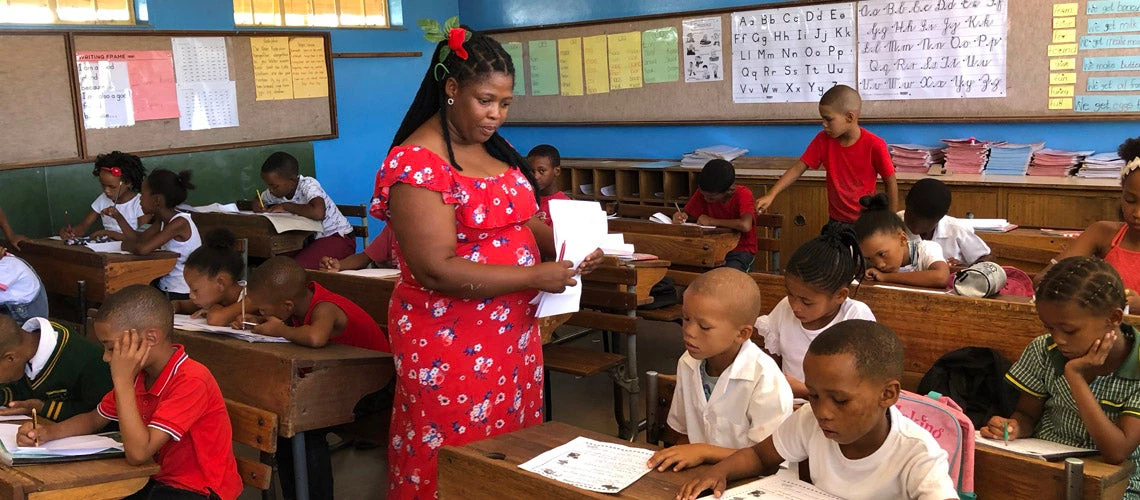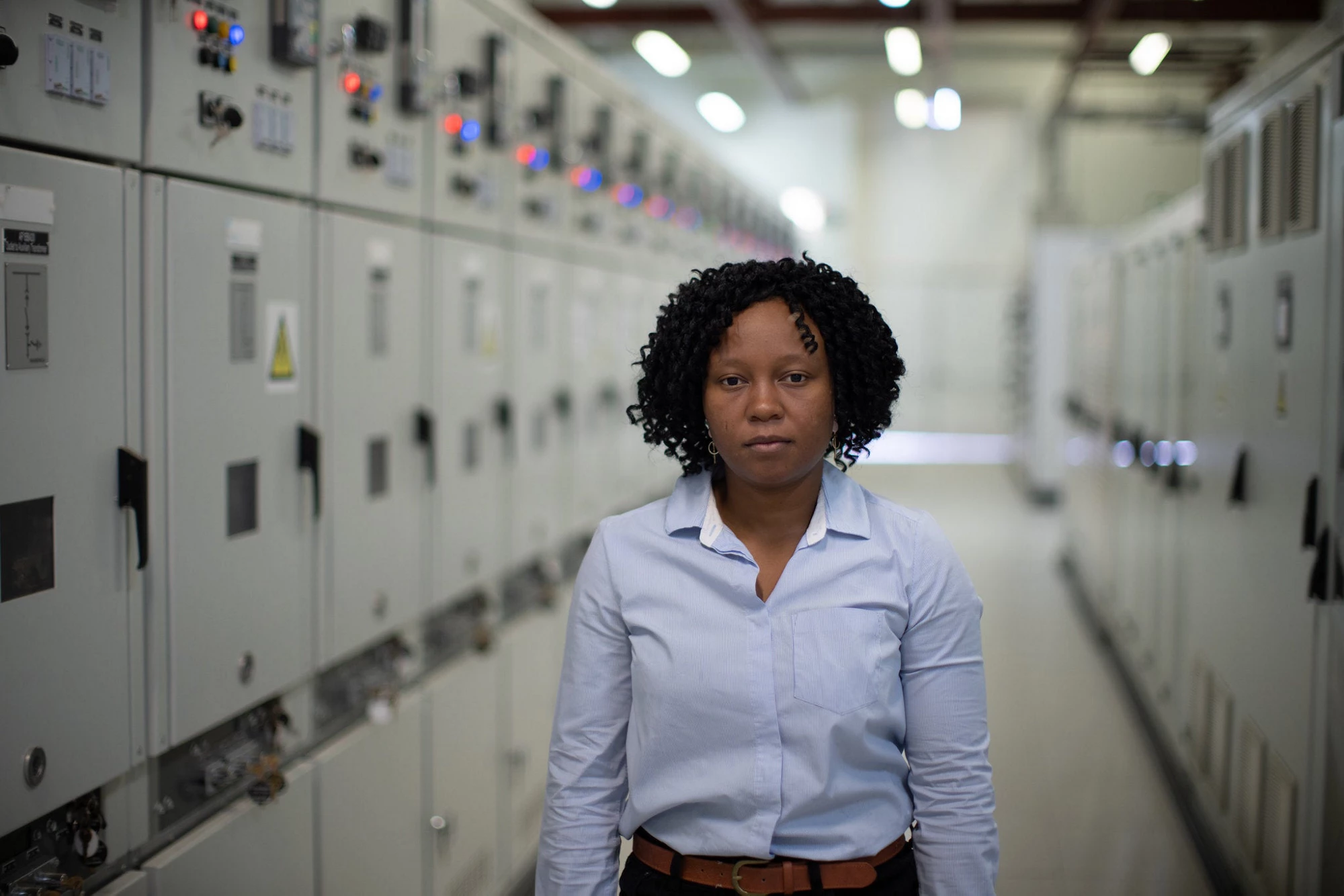 A class in the Boesmanland School in Pofadder, Northern Cape Province, South Africa
A class in the Boesmanland School in Pofadder, Northern Cape Province, South Africa
As my plane flies over Upington, the landscape looks like it’s out of a Mad Max movie. Besides being among the least populated areas in the world, with three people per square kilometer, the Northern Cape is also the driest and hottest province in South Africa. Temperatures can reach 50 degrees Celsius during summer months.
It is also home to three solar plants called Xina, KaXu and Khi: concentrated solar power (CSP) plants, with KaXu being the first ever built in a developing country. These have put South Africa at the forefront of modern solar technology.
Costing $2 billion, these plants testify to the power of partnership. They were built by the engineering and construction company Abengoa, and financed by several partners, including close to $100 million from the Climate Investment Funds (CIF), as well as the South African government, private companies and multilateral development banks. The African Development Bank (AfDB) contributed $90 million for Xina, and the International Finance Corporation (IFC) (the private sector arm of the World Bank Group) provided $250 million for all three. With development led by the South African government, the plants now operate through agreements between private firms and the public electric utility, Eskom.
With a combined capacity of 250 megawatts, the plants keep nearly 800,000 metric tons of carbon dioxide out of the atmosphere every year, equivalent to almost 320 million liters of gasoline. That is roughly enough to drive around the equator more than 88,000 times.
The facilities take your breath away. Their engineering represents the height of human ingenuity, giving hope that we can address climate change.
The Northern Cape has been dubbed South Africa’s “green hub” because of its numerous solar installations, both CSP and photovoltaic (PV) plants. The province has some of the world’s highest levels of solar radiation — and plenty of space to spare. José Cayuela, Khi’s General Manager, described it as, “a perfect area for solar technology.”
Unlike PV systems, CSP plants can provide energy when the sun isn’t shining. As Christiaan Rudolph Van Rooyen, Xina’s General Manager, said, “We can store the energy and then dispatch it during peak times when it is most critical to the country.”
From internships to steady jobs
While these plants are vital to tackling climate change, they have also brought impressive economic benefits to the surrounding communities. Jobs are of vital importance in a country like South Africa with an unemployment rate exceeding 30%. A lot of attention nationally and locally is focused on creating decent work and ensuring that any transition to renewable energy is socially inclusive. So more good news comes from the contributions the plants have made to local communities.
“The impact has been massive,” said Van Rooyen, pointing to a corporate social responsibility program that has already benefited more than 5,000 people. The construction of the plants generated thousands of jobs, mostly for local people. And, once the structures were finished, additional employment opportunities became available. Today, the plants offer 18 internships every year that often lead to full-time work.
In recent years, there has been a growing focus on “just transitions” in South Africa, a concept that underscores the need to achieve necessary changes for sustainable development in a manner that protects workers and communities, and ensures equitable distribution of benefits and risks. CIF is working to develop a broader understanding of such transitions to ensure that it continues to contribute to reducing climate change while enhancing socio-economic progress.

Education first
Today, through social development programs, Xina, KaXu, and Khi are already caring for future generations, addressing social welfare, enterprise development, infrastructure and education, with the last as a clear priority. Starting from elementary school, and up to university level, as I learned from Bradley and Othmar, 2 out of the 20 recipients of scholarships available to communities, that allowed them to attend universities in the Cape Town area.
These programs are funded through a 1% allocation of revenue from the solar plants as part of a national private renewable energy policy. In fact, since 2011, South Africa’s Renewable Energy Independent Power Producers Procurement Programme has required independent power producers to reinvest in local communities within 50 kilometers of a project site as a core aspect of each project’s design and approval.
In the community of Onseepkans, I met many beneficiaries of social and educational projects made possible by the plants. Activities such as community and social gardens which encourage sound agricultural practices, besides ensuring access fresh produce to families. A community kitchen where local women prepare a daily meal for 150 children, which is often the only proper meal available to those from the most disadvantaged families. And a rich program of after-school activities, providing children with a safe space to play and learn.
Unlocking low-carbon markets
Funds such as CIF are instrumental in unlocking low-carbon markets. When I look back at the week I spent in the Northern Cape, I see how economic growth can be aligned with environmental protection, and energy production with human needs. The experience affirms that we can respond to increased energy needs with climate-smart solutions.
These plants are also foundations for a sustainable future that we can build globally, because, as Van Rooyen noted, “We cannot forget why we started originally with renewable energies. It was not just to create jobs. It was for the protection of our environment and the world our children are going to live in one day.”
Adapted from this in-depth article bringing in stories and voices of those working in the plants and living around them.


Join the Conversation